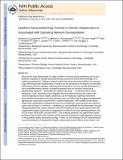Cytokine-associated drug toxicity in human hepatocytes is associated signaling network dysregulation
Author(s)
Hendriks, Bart S.; Cosgrove, Benjamin D.; Alexopoulos, Leonidas G.; Hang, Ta-Chun; Sorger, Peter K.; Griffith, Linda G.; Lauffenburger, Douglas A.; ... Show more Show less
DownloadLauffenburger-2010-Cytokine-Associated Drug Toxicity.pdf (2.559Mb)
OPEN_ACCESS_POLICY
Open Access Policy
Creative Commons Attribution-Noncommercial-Share Alike
Terms of use
Metadata
Show full item recordAbstract
Idiosyncratic drug hepatotoxicity is a major problem in pharmaceutical development due to poor prediction capability of standard preclinical toxicity assessments and limited knowledge of its underlying mechanisms. Findings in animal models have shown that adverse effects of numerous drugs with idiosyncratic hepatotoxicity in humans can be reproduced in the presence of coincident inflammatory cytokine signaling. Following these observations, we have recently developed an in vitro drug/inflammatory cytokine co-treatment approach that can reproduce clinical drug hepatotoxicity signatures—particularly for idiosyncratic drugs—in cultured primary human hepatocytes. These observations have suggested that drug-induced stresses may interact with cytokine signaling to induce hepatic cytotoxicity, but the hepatocyte signaling mechanisms governing these interactions are poorly understood. Here, we collect high-throughput phosphoprotein signaling and cytotoxicity measurements in cultured hepatocytes, from multiple human donors, treated with combinations of hepatotoxic drugs (e.g. trovafloxacin, clarithromycin) and cytokines (tumor necrosis factor-α, interferon-γ, interleukin-1α, and interleukin-6). We demonstrate, through orthogonal partial least-squares regression (OPLSR) modeling of these signal-response data, that drug/cytokine hepatic cytotoxicity is integratively controlled by four key signaling pathways: Akt, p70 S6 kinase, MEK–ERK, and p38–HSP27. This modeling predicted, and experimental studies confirmed, that the MEK–ERK and p38–HSP27 pathways contribute pro-death signaling influences in drug/cytokine hepatic cytotoxicity synergy. Further, our four-pathway OPLSR model produced successful prediction of drug/cytokine hepatic cytotoxicities across different human donors, even though signaling and cytotoxicity responses were both highly donor-specific. Our findings highlight the critical role of kinase signaling in drug/cytokine hepatic cytotoxicity synergies and reveal that hepatic cytotoxicity responses are governed by multi-pathway signaling network balance.
Description
Refer to Web version on PubMed Central for supplementary material.
Date issued
2010-04Department
Massachusetts Institute of Technology. Biotechnology Process Engineering Center; Massachusetts Institute of Technology. Department of Biological EngineeringJournal
Molecular BioSystems
Publisher
Royal Society of Chemistry
Citation
Cosgrove, Benjamin D. et al. “Cytokine-associated drug toxicity in human hepatocytes is associated with signaling network dysregulation.” Molecular BioSystems 6 (2010): 1195. Web. 16 Nov. 2011. © 2010 Royal Society of Chemistry
Version: Author's final manuscript
ISSN
1742-206X
1742-2051